check engine MITSUBISHI L200 2015 (in English) Owner's Guide
[x] Cancel search | Manufacturer: MITSUBISHI, Model Year: 2015, Model line: L200, Model: MITSUBISHI L200 2015Pages: 418, PDF Size: 25.8 MB
Page 349 of 418
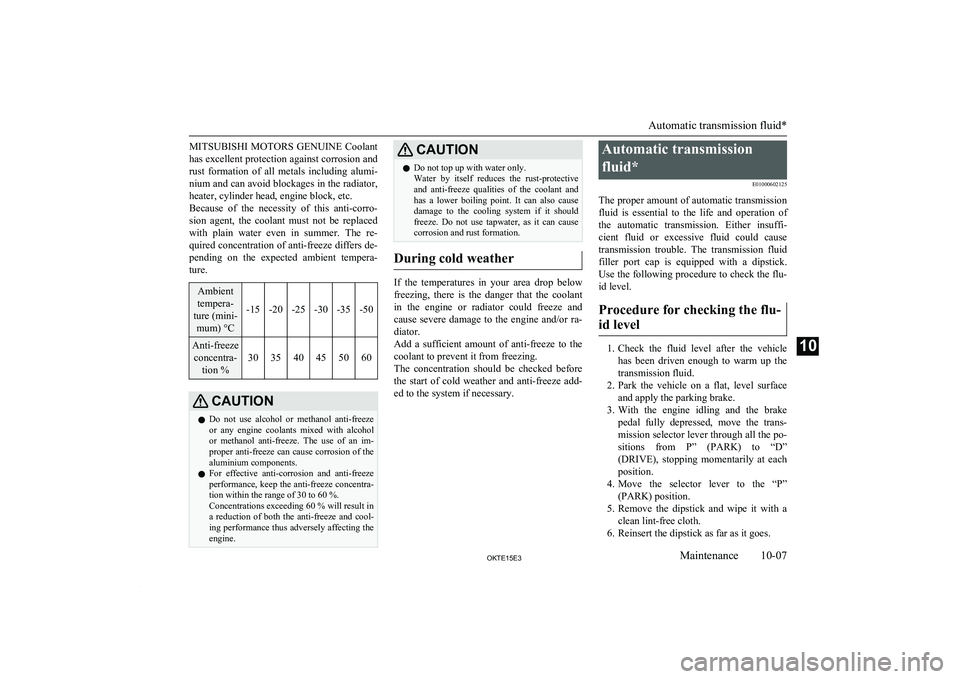
MITSUBISHI MOTORS GENUINE Coolant
has excellent protection against corrosion and rust formation of all metals including alumi-
nium and can avoid blockages in the radiator, heater, cylinder head, engine block, etc.
Because of the necessity of this anti-corro-
sion agent, the coolant must not be replaced with plain water even in summer. The re-
quired concentration of anti-freeze differs de-
pending on the expected ambient tempera- ture.Ambient
tempera-
ture (mini- mum) °C
-15-20-25-30-35-50
Anti-freezeconcentra- tion %
303540455060CAUTIONl Do not use alcohol or methanol anti-freeze
or any engine coolants mixed with alcohol
or methanol anti-freeze. The use of an im- proper anti-freeze can cause corrosion of the
aluminium components.
l For effective anti-corrosion and anti-freeze
performance, keep the anti-freeze concentra-tion within the range of 30 to 60 %.
Concentrations exceeding 60 % will result in
a reduction of both the anti-freeze and cool-
ing performance thus adversely affecting the
engine.CAUTIONl Do not top up with water only.
Water by itself reduces the rust-protective and anti-freeze qualities of the coolant and
has a lower boiling point. It can also cause damage to the cooling system if it should freeze. Do not use tapwater, as it can causecorrosion and rust formation.
During cold weather
If the temperatures in your area drop below
freezing, there is the danger that the coolant
in the engine or radiator could freeze and cause severe damage to the engine and/or ra-diator.
Add a sufficient amount of anti-freeze to the
coolant to prevent it from freezing.
The concentration should be checked before the start of cold weather and anti-freeze add- ed to the system if necessary.
Automatic transmission
fluid* E01000602125
The proper amount of automatic transmission fluid is essential to the life and operation of
the automatic transmission. Either insuffi- cient fluid or excessive fluid could causetransmission trouble. The transmission fluid filler port cap is equipped with a dipstick.Use the following procedure to check the flu-
id level.
Procedure for checking the flu- id level
1. Check the fluid level after the vehicle
has been driven enough to warm up the
transmission fluid.
2. Park the vehicle on a flat, level surface
and apply the parking brake.
3. With the engine idling and the brake
pedal fully depressed, move the trans- mission selector lever through all the po-sitions from P” (PARK) to “D”
(DRIVE), stopping momentarily at each position.
4. Move the selector lever to the “P”
(PARK) position.
5. Remove the dipstick and wipe it with a
clean lint-free cloth.
6. Reinsert the dipstick as far as it goes.
Automatic transmission fluid*
10-07OKTE15E3Maintenance10
Page 350 of 418
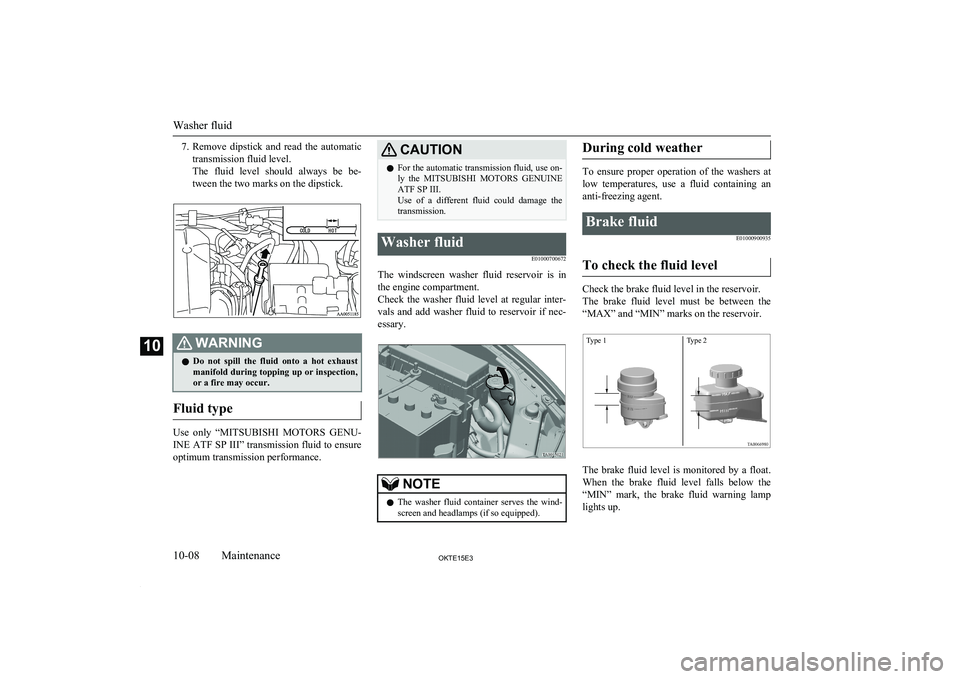
7.Remove dipstick and read the automatic
transmission fluid level.
The fluid level should always be be-
tween the two marks on the dipstick.WARNINGl Do not spill the fluid onto a hot exhaust
manifold during topping up or inspection, or a fire may occur.
Fluid type
Use only “ MITSUBISHI MOTORS GENU-
INE ATF SP III” transmission fluid to ensure
optimum transmission performance.
CAUTIONl For the automatic transmission fluid, use on-
ly the MITSUBISHI MOTORS GENUINE
ATF SP III.
Use of a different fluid could damage the transmission.Washer fluid
E01000700672
The windscreen washer fluid reservoir is inthe engine compartment.
Check the washer fluid level at regular inter- vals and add washer fluid to reservoir if nec-
essary.
NOTEl The washer fluid container serves the wind-
screen and headlamps (if so equipped).During cold weather
To ensure proper operation of the washers at
low temperatures, use a fluid containing ananti-freezing agent.
Brake fluid
E01000900935
To check the fluid level
Check the brake fluid level in the reservoir.
The brake fluid level must be between the “MAX” and “MIN” marks on the reservoir.
The brake fluid level is monitored by a float.
When the brake fluid level falls below the “MIN” mark, the brake fluid warning lamp
lights up.
Washer fluid
10-08OKTE15E3Maintenance10 Type 1 Type 2
Page 352 of 418
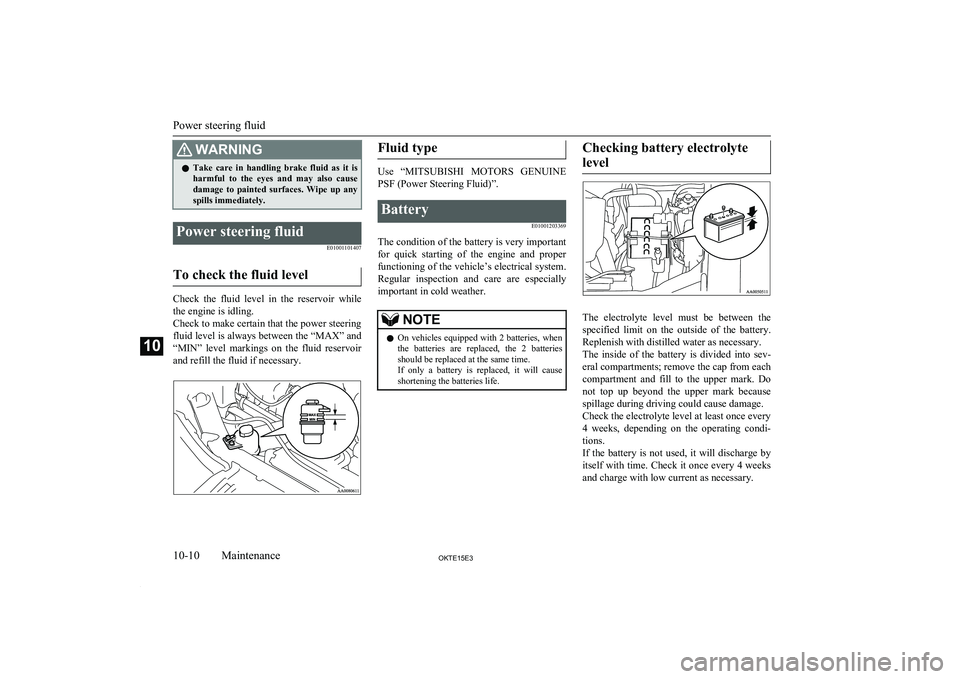
WARNINGlTake care in handling brake fluid as it is
harmful to the eyes and may also cause
damage to painted surfaces. Wipe up any spills immediately.Power steering fluid
E01001101407
To check the fluid level
Check the fluid level in the reservoir whilethe engine is idling.
Check to make certain that the power steering
fluid level is always between the “MAX” and
“MIN” level markings on the fluid reservoir
and refill the fluid if necessary.
Fluid type
Use “ MITSUBISHI MOTORS GENUINE
PSF (Power Steering Fluid)”.
Battery
E01001203369
The condition of the battery is very important
for quick starting of the engine and proper functioning of the vehicle’s electrical system.
Regular inspection and care are especially
important in cold weather.
NOTEl On vehicles equipped with 2 batteries, when
the batteries are replaced, the 2 batteries
should be replaced at the same time.
If only a battery is replaced, it will cause shortening the batteries life.Checking battery electrolyte
level
The electrolyte level must be between the specified limit on the outside of the battery.
Replenish with distilled water as necessary.
The inside of the battery is divided into sev- eral compartments; remove the cap from each
compartment and fill to the upper mark. Do not top up beyond the upper mark because
spillage during driving could cause damage.
Check the electrolyte level at least once every
4 weeks, depending on the operating condi- tions.
If the battery is not used, it will discharge by
itself with time. Check it once every 4 weeks and charge with low current as necessary.
Power steering fluid
10-10OKTE15E3Maintenance10
Page 359 of 418
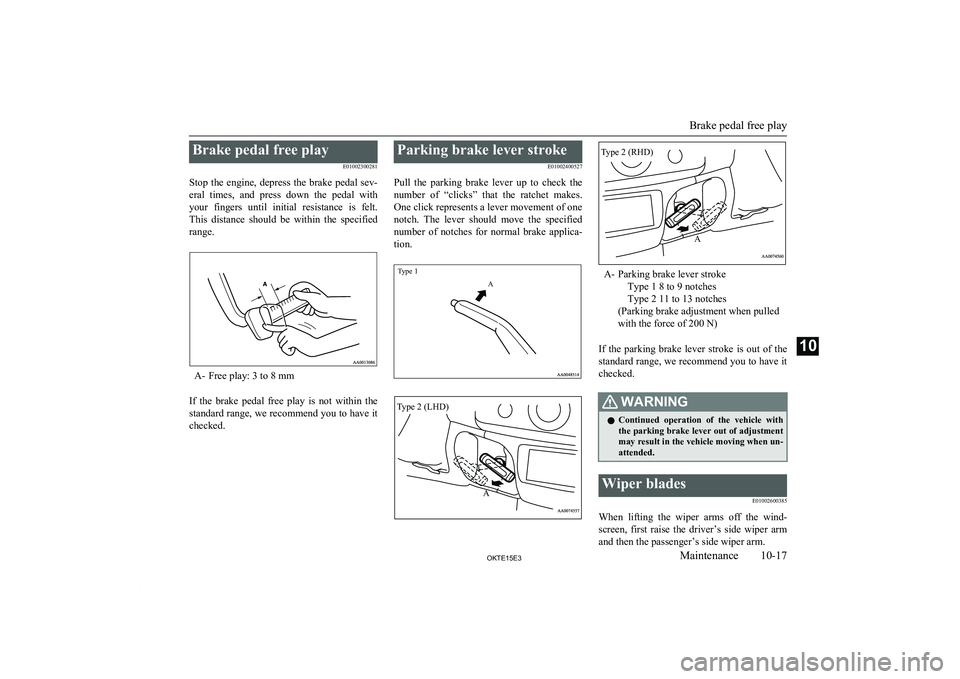
Brake pedal free playE01002300281
Stop the engine, depress the brake pedal sev- eral times, and press down the pedal with
your fingers until initial resistance is felt. This distance should be within the specified
range.
A- Free play: 3 to 8 mm
If the brake pedal free play is not within the standard range, we recommend you to have it
checked.
Parking brake lever stroke
E01002400527
Pull the parking brake lever up to check the number of “clicks” that the ratchet makes.
One click represents a lever movement of one
notch. The lever should move the specified number of notches for normal brake applica-
tion.
Type 1A
A- Parking brake lever stroke
Type 1 8 to 9 notches
Type 2 11 to 13 notches
(Parking brake adjustment when pulled
with the force of 200 N)
If the parking brake lever stroke is out of the
standard range, we recommend you to have it
checked.
WARNINGl Continued operation of the vehicle with
the parking brake lever out of adjustment
may result in the vehicle moving when un- attended.Wiper blades
E01002600385
When lifting the wiper arms off the wind-screen, first raise the driver’s side wiper arm
and then the passenger’s side wiper arm.
Brake pedal free play
10-17OKTE15E3Maintenance10 Type 2 (LHD)
A Type 2 (RHD)
A
Page 361 of 418
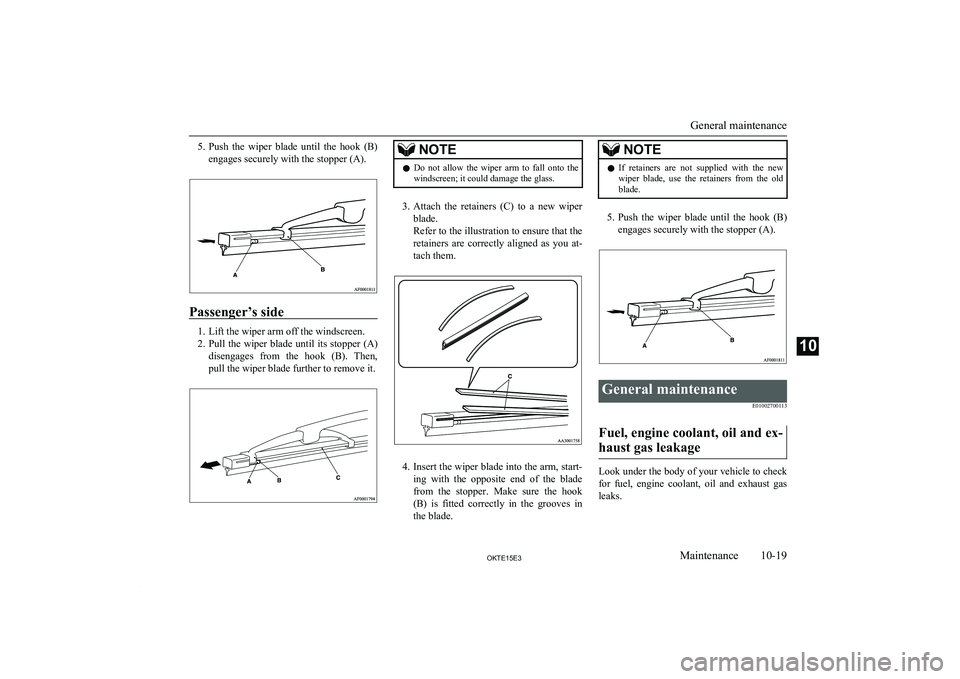
5.Push the wiper blade until the hook (B)
engages securely with the stopper (A).
Passenger’s side
1. Lift the wiper arm off the windscreen.
2. Pull the wiper blade until its stopper (A)
disengages from the hook (B). Then, pull the wiper blade further to remove it.
NOTEl Do not allow the wiper arm to fall onto the
windscreen; it could damage the glass.
3. Attach the retainers (C) to a new wiper
blade.
Refer to the illustration to ensure that the
retainers are correctly aligned as you at- tach them.
4. Insert the wiper blade into the arm, start-
ing with the opposite end of the blade from the stopper. Make sure the hook(B) is fitted correctly in the grooves inthe blade.
NOTEl If retainers are not supplied with the new
wiper blade, use the retainers from the old
blade.
5. Push the wiper blade until the hook (B)
engages securely with the stopper (A).
General maintenance
E01002700113
Fuel, engine coolant, oil and ex-
haust gas leakage
Look under the body of your vehicle to check
for fuel, engine coolant, oil and exhaust gas
leaks.
General maintenance
10-19OKTE15E3Maintenance10
Page 362 of 418
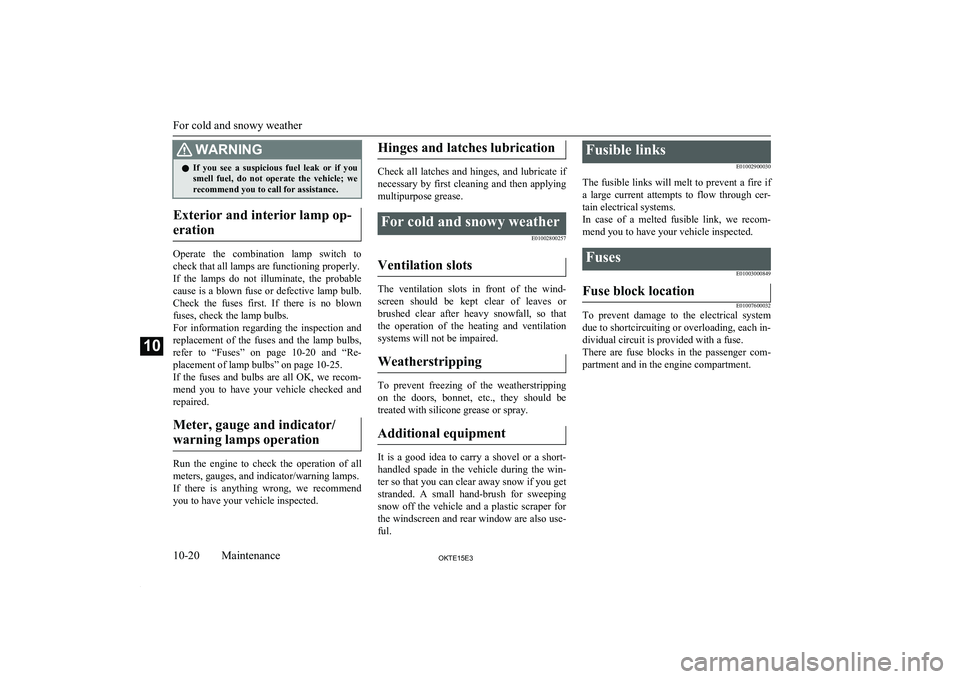
WARNINGlIf you see a suspicious fuel leak or if you
smell fuel, do not operate the vehicle; werecommend you to call for assistance.
Exterior and interior lamp op-
eration
Operate the combination lamp switch to
check that all lamps are functioning properly.
If the lamps do not illuminate, the probable cause is a blown fuse or defective lamp bulb.
Check the fuses first. If there is no blown
fuses, check the lamp bulbs.
For information regarding the inspection and
replacement of the fuses and the lamp bulbs, refer to “Fuses” on page 10-20 and “Re-
placement of lamp bulbs” on page 10-25.
If the fuses and bulbs are all OK, we recom- mend you to have your vehicle checked and
repaired.
Meter, gauge and indicator/warning lamps operation
Run the engine to check the operation of all meters, gauges, and indicator/warning lamps.
If there is anything wrong, we recommend you to have your vehicle inspected.
Hinges and latches lubrication
Check all latches and hinges, and lubricate if
necessary by first cleaning and then applying
multipurpose grease.
For cold and snowy weather
E01002800257
Ventilation slots
The ventilation slots in front of the wind-
screen should be kept clear of leaves or brushed clear after heavy snowfall, so that
the operation of the heating and ventilation
systems will not be impaired.
Weatherstripping
To prevent freezing of the weatherstripping
on the doors, bonnet, etc., they should be treated with silicone grease or spray.
Additional equipment
It is a good idea to carry a shovel or a short- handled spade in the vehicle during the win-ter so that you can clear away snow if you get
stranded. A small hand-brush for sweeping snow off the vehicle and a plastic scraper for
the windscreen and rear window are also use- ful.
Fusible links
E01002900030
The fusible links will melt to prevent a fire if
a large current attempts to flow through cer- tain electrical systems.
In case of a melted fusible link, we recom- mend you to have your vehicle inspected.Fuses
E01003000849Fuse block location
E01007600032
To prevent damage to the electrical systemdue to shortcircuiting or overloading, each in-dividual circuit is provided with a fuse.
There are fuse blocks in the passenger com- partment and in the engine compartment.
For cold and snowy weather
10-20OKTE15E3Maintenance10
Page 405 of 418

4
4-wheel drive operation.....................................6-38A
Accessory (Installation).....................................2-03
Accessory socket............................................. 7-109
Active Stability & Traction Control (ASTC).... 6-48
Additional equipment...................................... 10-20
Air conditioning Automatic air conditioning........................... 7-09
Important operation tips for the air conditioning................................................. 7-14
Manual air conditioning................................ 7-04
Air purifier.........................................................7-14
Airbag................................................................ 4-28
Antenna............................................................. 7-83
Anti-lock brake system (ABS).......................... 6-45 Warning lamp................................................6-46
Armrest (Double cab)........................................ 4-08
Ashtray............................................................ 7-107
Audio Audio system anti-theft feature..................... 7-49
CD player...................................................... 7-51
Error codes.................................................... 7-47
Handling of compact discs............................ 7-49
LW/MW/FM electronic tuning ra- dio with CD player...................................... 7-15
LW/MW/FM radio........................................ 7-51
Steering wheel remote control switch...7-44,7-63
Troubleshooting............................................ 7-80
Automatic air conditioning................................7-09
Automatic transmission Sports Mode 4A/T, 5A/T.......................................................6-19
Fluid.................................................. 10-07,11-22
Selector lever operation................................ 6-19
Selector lever position indicator................... 6-20
Selector lever positions................................. 6-20
Sports mode.................................................. 6-21
Sports mode indicator................................... 6-22
B
Battery............................................................. 10-10Discharged battery (Emergency starting)..... 8-02
Specification............................................... 11-18
Bleeding the fuel system................................... 8-05
Bluetooth® 2.0 interface................................... 7-84
Bonnet............................................................. 10-03
Bottle holder.................................................... 7-115
Brake Anti-lock brake............................................. 6-45
Brake assist system....................................... 6-44
Braking.......................................................... 6-43
Fluid.................................................. 10-08,11-22
Parking brake................................................ 6-07
Parking brake lever stroke.......................... 10-17
Pedal free play.............................................10-17
Warning lamp................................................5-08
C
Cargo loads........................................................6-55
Catalytic converter.......................................... 10-02
Cautions on handling of 4-wheel drive vehicles................................................... 6-41
Central door locks............................................. 3-07
Centre console downlight................................ 7-111 Bulb capacity.............................................. 10-26
Replacement................................................ 10-38
Centre information display................................ 5-10
Changing a fuse............................................... 10-23
Changing gears.................................................. 6-16
Check engine warning lamp.............................. 5-08
Child restraint.................................................... 4-14
Child-protection rear doors............................... 3-08
Cigarette lighter............................................... 7-108
Cleaning Exterior of your vehicle................................ 9-03Genuine leather............................................. 9-03 Interior of your vehicle................................. 9-02
Plastic, vinyl leather, etc............................... 9-02
Sunroof.......................................................... 9-06
Waxing.......................................................... 9-04
Clock....................................................... 5-20,7-109
Clutch Fluid.................................................. 10-09,11-22
Pedal free play.............................................10-16
Coat hook........................................................ 7-116
Combination headlamps and dipper switch...... 5-32
Convenient hook............................................. 7-116
Coolant (engine)....................................10-06,11-22
Cruise control.................................................... 6-50 Switch........................................................... 6-51
Cup holder....................................................... 7-115
Curtain airbag system........................................ 4-37
D
Demister (rear window).................................... 5-43
Alphabetical index
12- 1
OKTE15E3Alphabetical index